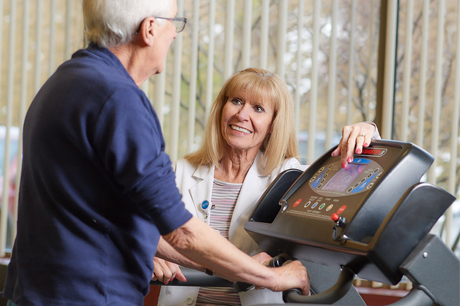Got a heart condition? Get your ticker back in shape
Cardiac rehab can reduce risk factors
If you’ve ever broken your leg or badly sprained your leg, you may have endured a few weeks of physical rehabilitation to help you regain strength in the affected area. After working closely with a professional, you probably felt stronger, increased your range of motion and returned to your normal daily activity.
If you develop a heart condition and have a heart attack or go through heart surgery or a number of other hear-related issues, your doctor may also recommend a different kind of rehab: cardiac rehab.
"Cardiac rehab is most often for patients who have a heart attack, heart valve surgery, heart failure or bypass surgery," explained Dr. Madhava Rao, Geisinger cardiologist and director of Geisinger Community Medical Center’s cardiac rehabilitation program. "It’s a supervised way to help you make heart-healthy life choices to prevent future heart issues."
Cardiac rehabilitation programs are supervised by a medical professional. During rehab, patients will:
- Learn about a heart-healthy lifestyle. Patients will work with a dietitian and nutritionist to develop healthy eating habits, learn about how to manage their condition and get help to quit smoking or take other steps to improve their heart health and lower risk factors.
- Begin an exercise program. Therapists and physicians will design an exercise program to help you build strength, lose weight and improve your cardiovascular system. They’ll monitor your progress closely to prevent injury.
- Start counseling. Stress is a risk factor for many heart conditions. Counselors and therapists will work with you to identify what stresses you out and help you cope with it.
"The goal of cardiac rehab is to help you eat healthier, lose weight, get back to work and basically return to daily activities without help," said Dr. Rao. "But the best way to do that is with a team of professionals who can walk you carefully through each step."
Cardiac rehab can begin a few weeks after your heart-related event. The program might begin with a test or two, such as an electrocardiogram (EKG), an exercise test and possibly some blood work. You’ll also have a physical exam and discuss your medical history. This helps your cardiac rehab team design a program that’s right for you.
You may also set goals with your team, whether it’s to start a smoking cessation program, work up to a specified amount of aerobic exercise or lose weight.
After you begin your exercise and education program, you’ll slowly learn how to increase your exercise levels safely so you can strengthen your heart. During this process, your team will monitor your heart rate and blood pressure to ensure that you don’t show signs of another heart-related event.
The total length of the program depends on your specific condition, medical history and the goals that you set with your care team.
"Cardiac rehab can help you to feel more like yourself—or even better—after the program is over," said Dr. Rao. "The goal is to teach you skills you can incorporate into everyday life so you can improve your health for the rest of your life."
Dr. Madhava Rao, MD, is a cardiologist and sees patients at Geisinger Cardiology-Scranton. Talk to your doctor if you think you might be a candidate for cardiac rehab.

